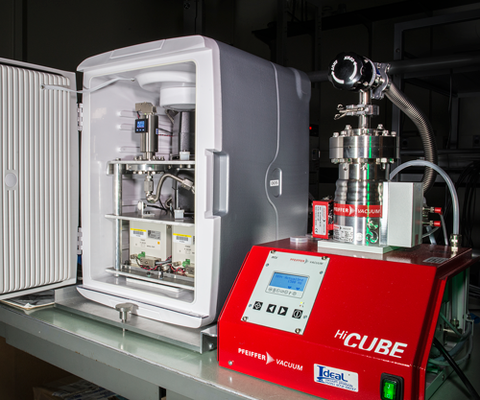
The PVS is housed within the white “igloo” enclosure at left. At right is an auxiliary vacuum system used for pressure calibrations.
A novel Portable Vacuum Standard (PVS) has been added to the roster of NIST's Standard Reference Instruments (SRI). It is now available for purchase as part of NIST's ongoing commitment to disseminate measurement standards and thereby reduce the need for the expensive and time-consuming process of transporting customer instruments to NIST for calibration.
The PVS is a compact, high-accuracy, low-pressure/vacuum laboratory standard that is calibrated directly against the primary standard at NIST. It enables high-precision calibrations, measurements, or inter-laboratory comparisons (ILC) at a customer's facility.
It can be used as a direct replacement for a commercial mercury manometer, while offering similar or better uncertainties and lower cost of ownership. The PVS package is also more rugged and does not contain mercury – a significant safety issue for the common high-accuracy manometers that it replaces.
Many customers do not have the technical expertise to build their own standards or only need a standard for a short period of time, such as during an ILC. For about $100,000 per unit (depending on specifications and configuration), the PVS can meet those needs. NIST will provide the relevant calibration reports and method for analyzing the measurements.
The latest version of the standard, which has been under development for more than a decade by scientists in NIST's Thermodynamic Metrology Group, enables pressure measurements from 1 Pa to 130,000 Pa. (Air pressure at sea level is about 101,325 Pa.) It is possible to extend the instrument's range to 370,000 Pa as needed.
The PVS combines two different kinds of low-pressure sensors enclosed in an insulated container the size of a suitcase that maintains a constant internal temperature to within 5 mK. The first is a resonance silicon gauge (RSG) that monitors two capacitance diaphragm gauges (CDGs). RSGs are microelectromechanical systems (MEMS) that measure the effect of pressure- induced strain on the resonant frequency of a silicon oscillator. CDGs measure pressure-induced changes in the position of an alloy diaphragm that serves as one plate of a capacitor, and are the workhorse sensors for most high-precision vacuum operations.
Combining the two, says project scientist Jay Hendricks, brings unique benefits: "CDGs have extremely fine resolution at low pressure. RSGs have outstanding long-term drift stability—in the range of 0.01%, which is a factor of 10 better than the CDGs. So to get the best of both, we use an RSG to calibrate the CDGs."
Contact: Jacob Ricker, (301) 975-4475.
Any mention or image of commercial products within NIST web pages is for information only; it does not imply recommendation or endorsement by NIST.

